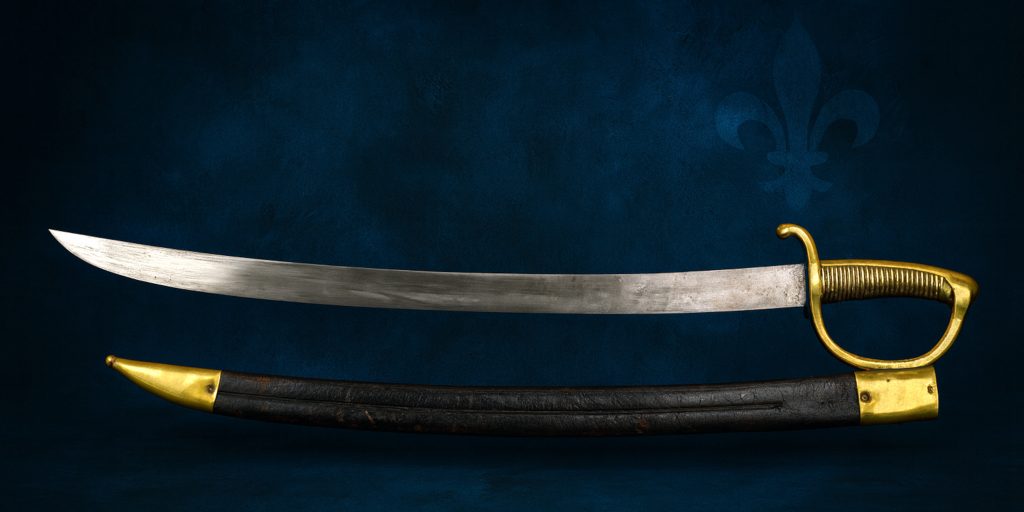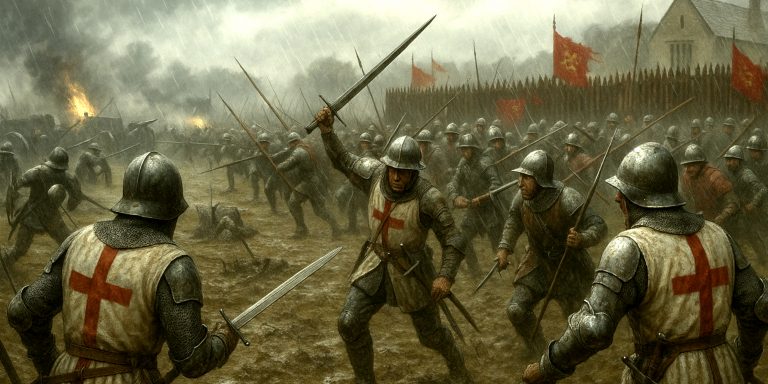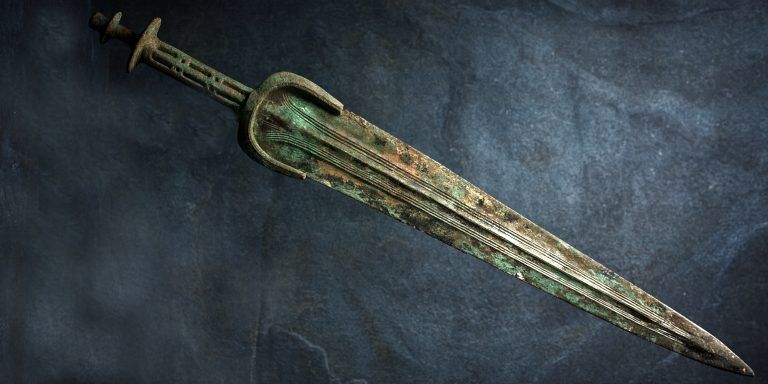
During the Napoleonic Wars (1803 to 1815), Europe was not only reshaped by cannon fire and massed musket volleys but also by the glitter of cold steel. The sword, though already becoming a secondary weapon in the age of gunpowder, remained a vital symbol of status and an effective tool in close combat. Whether clutched by charging cuirassiers, nimble hussars, steadfast infantry officers, or salty sailors boarding enemy decks, the sword was never far from the heart of Napoleonic warfare.
This was not a one-size-fits-all affair. Each branch of service carried blades tailored to its style of fighting. Heavy cavalry needed brute-force weapons for shock charges, light cavalry prized speed and cutting power, and officers of all stripes demanded something elegant enough for parade yet practical enough for battle. Let’s take a closer look at the steel that defined the age.
Cavalry Swords
Cavalry were the glamour troops of the period, and their swords reflected their roles.
Heavy Cavalry

Designed for raw impact, these swords favoured thrusting power and sheer weight.
- British 1796 Heavy Cavalry Sword – A straight, broad-bladed brute that looked more like a cleaver than a gentleman’s weapon. Infamous at Waterloo in 1815 for the carnage it caused.
- French AN XI Heavy Cavalry Sword – Straight-bladed and brutally effective, carried by Napoleon’s cuirassiers in their thunderous charges.
- Austrian 1769 & 1798 Heavy Cavalry Pallasch – Long, straight thrusting swords influenced by earlier Germanic designs, less refined but deadly in massed formations.
Light Cavalry

Speed and cutting ability mattered more than brute strength here.
- British 1796 Light Cavalry Sabre – Perhaps the most iconic sword of the wars, its sweeping curve perfect for slashing attacks. Inspired by Hungarian hussars, beloved by Britain’s light dragoons.
- French AN IV & AN XI Light Cavalry Sabres – Elegant curved sabres, standard issue for chasseurs à cheval and hussars who lived and died by mobility.
- Prussian 1811 Blücher Sabre – A faithful copy of the British 1796, so effective the Prussians adopted it wholesale.
Infantry Swords

Infantry were the workhorses of every army, but swords were mostly the preserve of officers or elite troops. Practicality often trumped flair.
- British 1796 Infantry Officer’s Sword – A straight, slender spadroon-type weapon more suited to duelling and ceremony than surviving a French bayonet charge.
- French Briquet Sabre (AN IX & AN XI) – A chunky short sword issued to grenadiers and voltigeurs. Its weight made it better for hacking brush than for duelling, but it was reliable in close scrapes.
- Austrian M1798 Infantry Officer’s Sword – Straight-bladed and serviceable, worn by officers who had more pressing duties than swordplay.
- Prussian 1808 Infantry Officer’s Sword – Another spadroon-like piece, a symbol of authority as much as a weapon.
Naval Swords
Life at sea demanded short, tough blades for cramped boarding actions and vicious melees on deck.
- British 1804 Royal Navy Cutlass – Sturdy and curved, the quintessential sailor’s weapon. Issued in bulk and swung with enthusiasm during the great fleet battles.
- French Naval Cutlass (Sabre de Bord AN XI) – Similar in form to the British version, used in the brutal chaos of boarding actions.
- Spanish M1802 Naval Cutlass – A heavy-duty blade for Spanish sailors, part tool, part weapon in the long wars at sea.
Artillery and Engineer Swords
Specialist troops had their own blades, often short and practical.
- British 1803 Flank Officer’s Sword – A curved sabre for light infantry and artillery officers, blending style with battlefield utility.
- French AN XI Artillery Sabre – Short, curved, and tough, ideal for artillery crews who needed sidearms for emergencies rather than lengthy duels.
- Prussian M1811 Artillery Sword – A no-nonsense straight blade, influenced by the British 1796 infantry sword.
Specialised and Officer Swords

The Napoleonic officer’s sword walked a fine line between weapon and jewellery. Some were elegant sidearms, others lavishly decorated symbols of rank.
- British 1803 Infantry Officer’s Sabre – A popular choice among light company and Rifle officers, marrying practicality with flair.
- French Empire Guard Officer’s Sword – Gilt, ornate, and as much a badge of honour as a blade, carried by Napoleon’s elite Guard.
- Spanish M1806 Officer’s Sword – A thrusting sword that served officers throughout the bitter campaigns of the Peninsular War.
Comparison Table: Napoleonic Swords at a Glance
| Sword | Nation | Type | Length (avg) | Weight (avg) | Role |
|---|---|---|---|---|---|
| British 1796 Heavy Cavalry Sword | Britain | Heavy Cavalry | 35 in (89 cm) | 2.5–3 lbs | Shock charges, brutal cuts and thrusts |
| French AN XI Heavy Cavalry Sword | France | Heavy Cavalry | 38 in (96 cm) | 3 lbs | Cuirassier charges, thrust-focused |
| Austrian Pallasch (1769/1798) | Austria | Heavy Cavalry | 37–39 in (94–99 cm) | 3 lbs | Thrusting, massed formations |
| British 1796 Light Cavalry Sabre | Britain | Light Cavalry | 33 in (84 cm) | 2.2 lbs | Slashing, speed and mobility |
| French AN XI Light Cavalry Sabre | France | Light Cavalry | 33 in (84 cm) | 2–2.5 lbs | Hussar and chasseur skirmishes |
| Prussian 1811 Blücher Sabre | Prussia | Light Cavalry | 33 in (84 cm) | 2.2 lbs | Copy of British 1796 sabre |
| French Briquet Sabre | France | Infantry | 24 in (61 cm) | 2 lbs | Grenadiers, close combat |
| British 1796 Infantry Sword | Britain | Infantry Officer | 32 in (81 cm) | 1.8 lbs | Officer sidearm, thrusting |
| British 1804 Cutlass | Britain | Naval | 27 in (69 cm) | 2.5 lbs | Boarding, close-quarters |
| French Naval Cutlass AN XI | France | Naval | 27 in (69 cm) | 2.5 lbs | Boarding actions |
| British 1803 Officer’s Sabre | Britain | Officer | 32 in (81 cm) | 2 lbs | Officer prestige, practical use |
Note: Lengths and weights vary slightly by manufacturer and surviving examples.
Collector’s Guide: Value, Museums, and Market Trends
For collectors, Napoleonic swords are both accessible and fascinating. They occupy a sweet spot in the antiques market: recognisable, often well-documented, and still relatively obtainable compared to medieval swords.
Auction Prices
- British 1796 Light Cavalry Sabre – Typically £800 to £2,500 depending on condition and provenance. Battle-scarred examples linked to Waterloo can fetch much higher.
- British 1796 Heavy Cavalry Sword – £1,000 to £3,500, with officer’s models or regimentally marked pieces commanding premiums.
- French Briquet Sabre – More common, usually £400 to £1,200. Scarce regimental markings add value.
- French AN XI Heavy Cavalry Sword – £1,500 to £4,000, with cuirassier examples especially desirable.
- Naval Cutlasses (British or French) – £600 to £2,000, though rare variants and engraved officer models may climb higher.
Where to See Them
- National Army Museum (London) – Holds fine examples of British 1796 sabres.
- Musée de l’Armée (Paris) – A treasure trove of French swords, including ornate Guard officer’s weapons.
- Imperial War Museum (London) – Displays Napoleonic cavalry swords alongside uniforms and pistols.
- Royal Armouries (Leeds) – Offers both cavalry and naval swords, including rare experimental models.
Market Insights
Collectors value swords with clear provenance. Regimental engravings, battle honours, or officer ownership all push prices higher. Condition is important, but many collectors enjoy the patina of service wear. Officer’s swords are generally scarcer than enlisted models, and presentation swords with inscriptions sit at the top end of the market.
The Seven Swords Takeaway
Swords of the Napoleonic Wars tell us as much about the men who carried them as the battles they fought. Heavy cavalry sabres embodied brute strength, light cavalry blades celebrated speed, naval cutlasses thrived in chaos, and officer’s swords glittered with prestige.
By 1815, the sword’s role as a decisive battlefield weapon was fading, overtaken by massed firepower and artillery. Yet these blades remain powerful symbols of an era when personal combat still mattered, and when an officer’s sword could be both a deadly tool and a statement of pride. Today, they are prized by collectors and historians alike, gleaming echoes of a Europe forged in steel and ambition.



